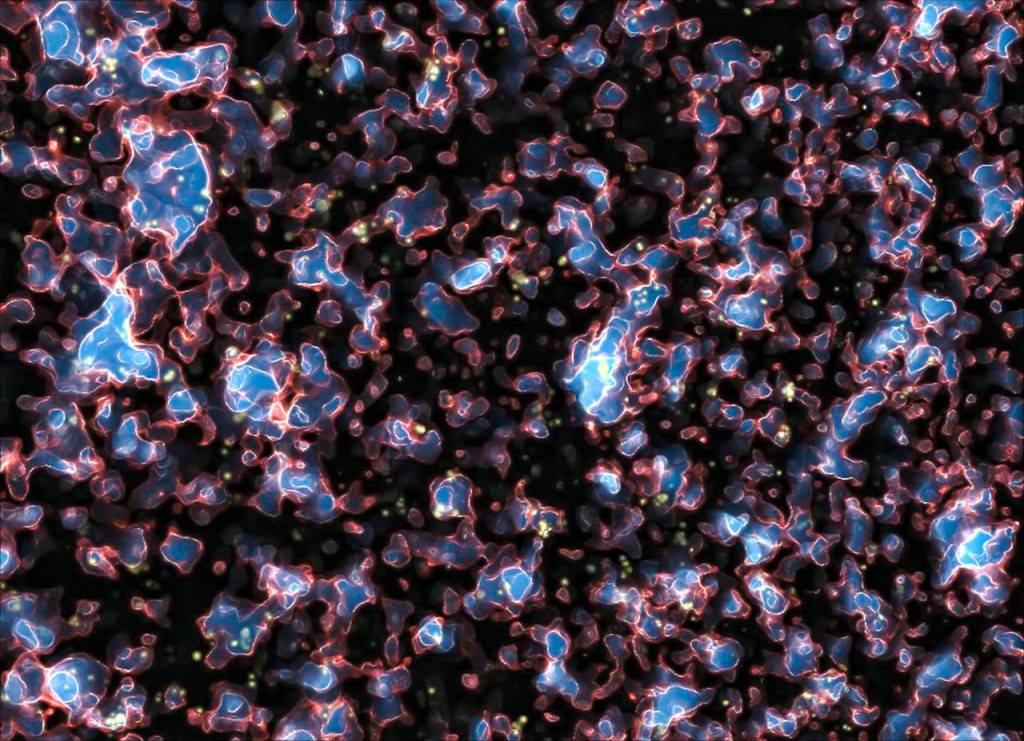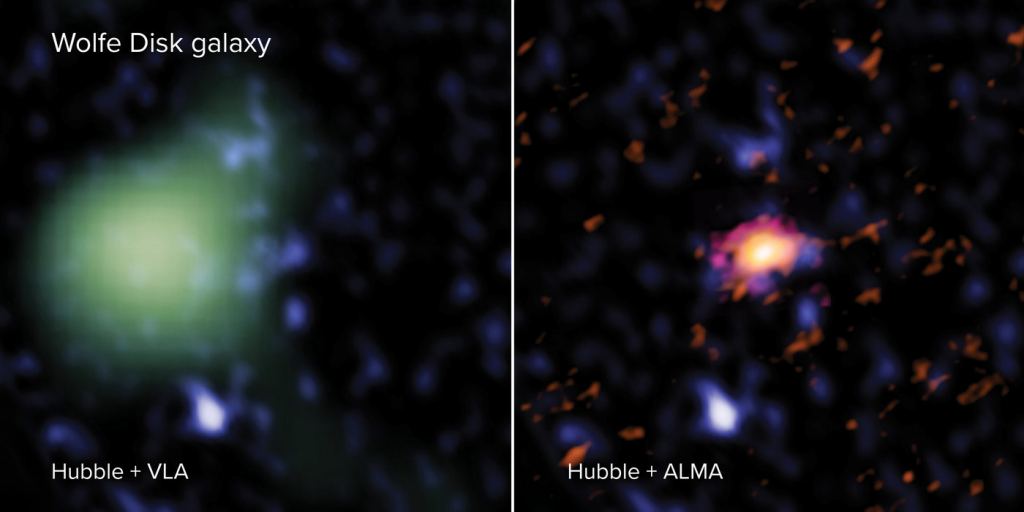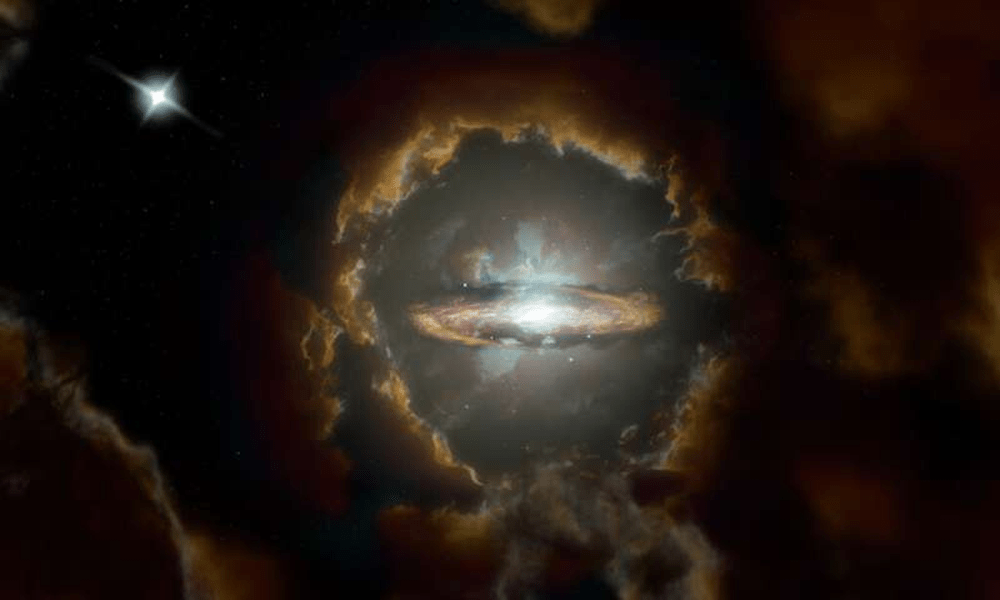If we want to understand how the Universe evolves, we have to understand how its large structures form and evolve. That’s why astronomers study galaxy formation. Galaxies are enormous structures of stars, planets, gas, dust, and dark matter, and understanding how they form is critical to understanding the Universe itself.
In 2017, astronomers working with ALMA (Atacama Large Millimeter/sub-millimeter Array) discovered an ancient galaxy. This massive rotating disk galaxy was born when the Universe was only about 1.5 billion years old. According to the most accepted understanding of how galaxies form and evolve, it shouldn’t exist.
But there it is.
The galaxy is known as DLA0817g, but it’s much easier-to-remember nickname is Wolfe’s galaxy, named after the late astronomer Arthur M. Wolfe. It’s the most ancient rotating disk galaxy astronomers have ever seen. By only 1.5 billion years after the Big Bang, Wolfe’s galaxy grew to 70 billion solar masses, about half as massive as the Milky Way.
There’s been some theoretical evidence that this type of galaxy might have existed this early in the Universe, but this is the first direct observational evidence.
A new study titled “A cold, massive, rotating disk galaxy 1.5 billion years after the Big Bang” presents these observations. Lead author of the study is Marcel Neeleman of the Max Planck Institute for Astronomy in Heidelberg, Germany. The paper is published in the journal Nature.
The Universe is about 13.8 billion years old. At first, it was just a hot, featureless plasma of electrons and protons, uniform in every direction. The challenge for cosmologists is to explain how all of that featureless mass combined into galaxies.

For the most part, astronomers thought that massive galaxies like our Milky Way formed over a long period of time, as things cooled down. That explanation is sometimes called the “hot mode” scenario. The hot mode scenario explains most of the messy, chaotic galaxies astronomers find in the early Universe, formed through mergers.
The other theory is the “cold mode accretion” scenario. That theory says that cold gas is led into a newly-formed galaxy on shorter time scales, before the Universe cooled down. Large simulations like Illustris TNG 50 show that rotating disk galaxies like Wolfe’s galaxy appeared earlier in the Universe than we thought. TNG 50 showed that these kinds of galaxies can emerge from chaotic, turbulent clouds of gas in earlier epochs.
Though always considered a possibility, there’s been no evidence of it. Until now.
“While previous studies hinted at the existence of these early rotating gas-rich disk galaxies, thanks to ALMA we now have unambiguous evidence that they occur as early as 1.5 billion years after the Big Bang,” said lead author Marcel Neeleman in a press release.
To understand what this discovery means, let’s take a look at dark matter, and the role it plays.
Dark matter is the backbone of the Universe’s structure. It’s like a network, and takes the shape of filaments and nodes which have more dark matter, and voids, which have less. It’s invisible to us, and makes up about 85% of the mass in the Universe. The other 15% comprises regular matter, like galaxies, stars, planets, and ourselves.

On a smaller scale, dark matter forms clump-like structures called halos. The regular matter is drawn to dark matter by gravitation, and takes shape around those halos and forms galaxies. But galaxies are made of stars, and for any of that to happen, the Universe had to have cooled down enough for stars to form. And by cool, we mean only 10 degrees above absolute zero.
The thing is, most of the early galaxies we can see are not rotating disks. They’re messy and disorganized, becuase they’ve grown through mergers with other galaxies. “Most galaxies that we find early in the universe look like train wrecks because they underwent consistent and often ‘violent’ merging” says Neeleman. “These hot mergers make it difficult to form well-ordered, cold rotating disks like we observe in our present universe.”

That’s because those mergers create all kinds of shock waves, which compress and heat gas, contributing to its disorderliness. And it should take billions of year before all of that messy gas can cool down, and take on an orderly, rotating disk shape.
But then there’s Wolfe’s galaxy. It’s a stately, cold, rotating disk galaxy.
Here’s what Neeleman and other researchers think happened.
Outside of the the early galaxy, there was gas that had already cooled; it hadn’t been subject to the compression, shock waves, and heating that the gas inside the galaxy had been subjected to. That cold gas flowed along filaments of dark matter, into the forming galaxy. That scenario means that rotating disk galaxies can form much earlier than the “collision and cooling” scenario.
The only way to show that the cold gas scenario was real, and could create cool rotating disk galaxies as shown in simulations like TNG 50, was to find one. And for that, you need to know where to look, and when.
Neeleman and the other researchers used ALMA and found six candidate galaxies. The light from those galaxies had to travel for about 10 billion years to reach us. DLA0817g, or Wolfe’s galaxy, was the brightest. It also displayed some Doppler shifts that showed it was a rotating disk, large and stable.

Their observations showed that it had a mass of about 70 billion Suns, and was about 1.5 billion years old. They’d found their cold-gas galaxy.
“We think the Wolfe Disk has grown primarily through the steady accretion of cold gas,” said co-author Xavier Prochaska, “Still, one of the questions that remains is how to assemble such a large gas mass while maintaining a relatively stable, rotating disk.”
There’s a reason they’ve named it Wolfe’s galaxy. Astronomer Arthur Wolfe was the PhD advisor for three of the authors. And Wolfe’s work directly helped the team find the galaxy.
Wolfe spent a long time researching light from distant quasars. The team behind this paper was able to find Wolfe’s galaxy by examining the light from a quasar as it passed through intervening matter. Quasars are extraordinarily luminous, emitting an enormous amount of light. In this case, the light passing through Wolfe’s galaxy is what allowed the team to identify and characterize the galaxy as a cold, rotating disk galaxy.
There are likely many more of these Wolfe galaxies, but they’re hard to find. They have to be positioned between us and a quasar in order to be identified. And that fortunate lining up is bound to be more uncommon than Wolfe galaxies themselves.
The only weak point in this study is the sample size of one. Though the results are promising and very interesting, astronomers will have to find more of these early, cold, rotating disk galaxies. You can’t re-write astronomical models on the basis of one data point. Is Wolfe’s galaxy representative of a type? Or is it just some kind of outlier?
Future studies will have to answer those questions.
More:
- Press Release: They grow up so fast: New observations show that massive disk galaxies formed exceptionally early in cosmic history
- Research Paper: A cold, massive, rotating disk galaxy 1.5 billion years after the Big Bang
- Universe Today: The First Results From The IllustrisTNG Simulation Of The Universe Has Been Completed, Showing How Our Cosmos Evolved From The Big Bang

